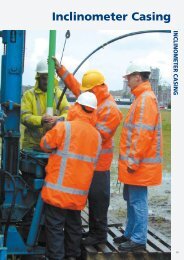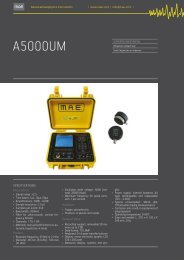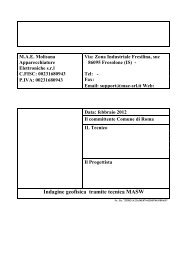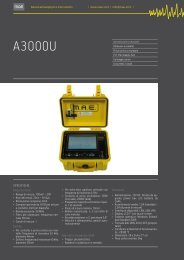Untitled
Untitled
Untitled
Create successful ePaper yourself
Turn your PDF publications into a flip-book with our unique Google optimized e-Paper software.
› Mae 47<br />
› S.E.O. (Horizontal electric explorations)<br />
This type of survey is carried out with<br />
the purpose to obtain a resistivity profile<br />
of the ground along a direction and<br />
at a certain depth. Each unhomogeneity<br />
in the medium tested, like bodies with<br />
different electric conduction capacity,<br />
is identified because it deflects the current<br />
lines and distorts the regular distribution<br />
of the electric potential. Furthermore,<br />
by measuring the potential<br />
drop on two random points, it is possible<br />
to determine the electric resistivity<br />
of the medium by multiplying the ratio<br />
between the potential drop and the<br />
current sent by a geometric coefficient<br />
which depends on the position of the<br />
electrodes on the ground. By changing<br />
the position of the electrode device on<br />
the area to test, it is possible to determine<br />
the distribution of the resistivity<br />
in the volume subject to electric current.<br />
Since rocks are resistive materials<br />
by nature, the resistivity variations are<br />
due almost exclusively to the presence<br />
of water in different quantities. The SEO<br />
is carried out by fixing 4 electrodes in<br />
the ground, two of which (the external<br />
ones) are for anchoring purposes<br />
and the other 2 (internal ones) are for<br />
measuring purposes, at a certain distance<br />
from each other. It is possible to<br />
obtain a horizontal profile of the resistivities<br />
of the grounds, which is useful<br />
to identify a vertical passage between<br />
two bodies with different resistivity.<br />
› RESISTIVITY TOMOGRAPHIC GEO-ELECTRIC PROFILE<br />
(Electric tomography)<br />
This type of survey is based on the<br />
calculation of the resistivity from the<br />
d.d.p measurements in the ground. The<br />
method is based on the introduction of<br />
an electric field in the ground through<br />
electrodes (input or current) and the<br />
measurement of the d.d.p. in other<br />
electrodes (of measurement type).<br />
From the d.d.p. value, it will be possible<br />
to find the resistivity value through the<br />
second law of Ohm, which is a typical<br />
characteristics of all materials. Since<br />
rocks are resistive materials by nature,<br />
the resistivity variations are due almost<br />
exclusively to the presence of water in<br />
different quantities. Electric tomography<br />
2D-3D is carried out by fixing electrode<br />
grids in the ground (16, 32, 64,<br />
128….) at constant pitch. All of them<br />
are connected to boxes which allow<br />
commutation among them, defining<br />
which are the measuring and current<br />
electrodes from time to time and automatically.<br />
The system will automatically<br />
perform all possible combinations.<br />
For this purpose, a series of measurements<br />
will be obtained (as many as the<br />
combinations available), based on: the<br />
number of electrodes and type of geometric<br />
configuration used. The tomographic<br />
inversion of the data obtained<br />
on the surface generates a bidimensional<br />
or tridimensional reconstruction<br />
in “output” of the ground, from which it<br />
is possible to identify possible anomalies<br />
due to cavities, water bodies, etc,<br />
and identify shapes, sizes and spatial<br />
distribution.









